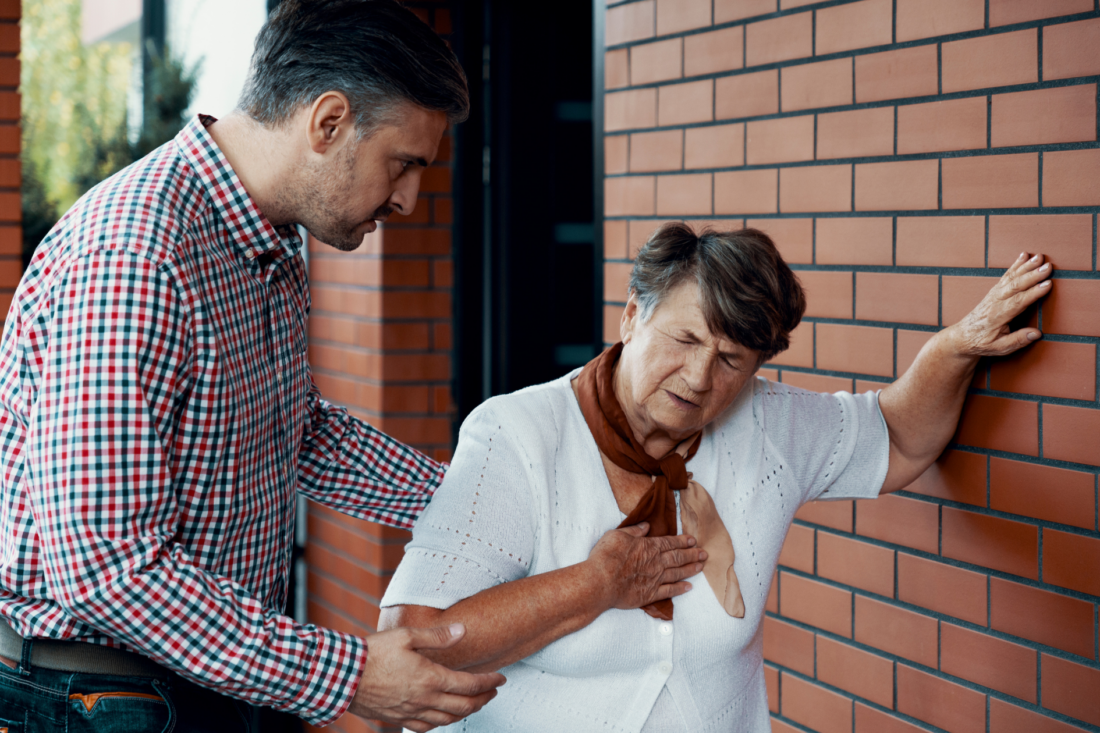
Dyspnea: Causes and Treatment for Shortness of Breath
Shortness of breath is a common complaint amongst patients at doctors’ visits. According to the Cleveland Clinic, 25% of patients who meet with their doctors report at least some shortness of breath. The medical term for this complaint is dyspnea, and it’s important to note that shortness of breath isn’t a standalone condition – it is a side effect. Doctors work to identify what is causing the dyspnea in order to treat the underlying condition.
Shortness of breath can either be a mild, temporary issue or a long-lasting condition that patients learn to live with. Unfortunately, there are many causes of dyspnea, which can make it hard for doctors to get to the source of the problem.
If you experience shortness of breath in any form, you may have an underlying medical condition that needs to be diagnosed and treated. Learn more about dyspnea and how to talk to your doctor about it.
Common Symptoms Related to Shortness of Breath
Dyspnea can present itself in multiple forms, and your doctor will likely ask you a series of questions to better understand what your breathing is like. A few ways you might experience dyspnea could include, but are not limited to, the following symptoms:
- shortness of breath after exertion or due to a medical condition
- feeling smothered or suffocated
- labored breathing
- tightness in the chest
- rapid breathing
- heart palpitations
- wheezing
- coughing
If your dyspnea occurs suddenly or if symptoms are severe, it may be a sign of a serious medical condition.
Causes of Dyspnea
There are several different causes of dyspnea, and experiencing shortness of breath doesn’t always mean you should have serious medical concerns. For example, you might feel dyspnea after completing an intense exercise – like reaching a personal weight-lifting goal or completing a 5k. Dyspnea is also commonly reported in people who experience changes in altitude or temperature. Leaving the warm Florida coast for a weekend ski trip in the Rocky Mountains of Denver can make you breathless.
However, dyspnea can be a sign of a serious health issue. Some of the most common causes of dyspnea include:
- Asthma
- Heart failure
- Chronic obstructive pulmonary disease (COPD)
- Interstitial lung disease
- Pneumonia
- Psychogenic problems related to anxiety
If you have ever felt stressed before a major exam or presentation at work, you may have experienced dyspnea. The tightness in your chest and difficulty breathing could be symptoms of a panic attack.
Causes of dyspnea can be physical, mental, and environmental. Environmental pollutants, like chemicals, fumes, dust, and smoke can trigger dyspnea. Seasonal triggers like pollen can worsen dyspnea symptoms. Lifestyle factors like smoking can also alert doctors to the cause of dyspnea. Even if you aren’t a smoker, you could experience shortness of breath by living or working with someone who smokes.
Your doctor has to sort through your symptoms and lifestyle to better understand what could lead you to have shortness of breath. They don’t want to misdiagnose anxiety or overexertion in the gym because they missed other signs that highlight a serious medical condition.
Acute vs. Chronic Dyspnea
There are two different types of dyspnea that you might experience. When you have shortness of breath suddenly and unexpectedly, you are feeling acute dyspnea. A few reasons you might experience this include:
- Asthma
- Anxiety
- Pneumonia
- Choking on something that blocks breathing passageways
- Allergic reactions
- Serious loss of blood, resulting in anemia
- Exposure to dangerous levels of carbon monoxide
- Heart failure
- Hypotension, which is low blood pressure
- Pulmonary embolism, which is a blood clot in a vessel leading to the lung
- Collapsed lung
You might not experience dyspnea for several months and then have a bout of shortness of breath during an anxiety attack or allergic reaction.
However, if you live with shortness of breath for more than a month, you have chronic dyspnea. Chronic dyspnea could be caused by a variety of factors including:
- Asthma
- COPD
- Heart problems
- Obesity
- Interstitial Pulmonary Fibrosis
- Croup
- Traumatic lung injury
- Lung cancer
- Tuberculosis
- Pleurisy
- Pulmonary edema or effusion
- Pulmonary hypertension
- Sarcoidosis
In the case of many of the above conditions, the lungs are unable to fill completely, there is pressure on the chest, or inflammation makes it hard to breathe. Shortness of breath can occur throughout the day for people with chronic dyspnea, which can make basic tasks like washing dishes or going to the grocery store exhausting and difficult.
When to See a Doctor About Dyspnea
Outside of the medical field, it can be hard to know when to see a doctor or call 911. Shortness of breath can be a sign of a life-threatening condition. You should seek out emergency medical treatment immediately if you experience any of these symptoms:
- Sudden onset of severe dyspnea
- Loss of ability to function due to shortness of breath
- Chest pain
- Nausea
Fortunately, not all cases of dyspnea require immediate medical treatment. However, shortness of breath can indicate serious medical problems. You should make an appointment with your doctor if you experience any of the following:
- A change in your ability to breathe
- Increasing limits on your activities due to breathing problems
- Difficulty breathing when lying down
- Swelling in your feet and ankles
- Fever, chills, and a cough
- Wheezing
Try to be as detailed as possible when describing your dyspnea to your doctor. The more information they have, the more confidently they can make a diagnosis.
Diagnosing Your Cause of Dyspnea
If you experience server or chronic dyspnea, make an appointment with one of our specialist health practitioners at Lyracore Health Alliance. We will perform a complete physical examination and ask comprehensive questions related to your symptoms. Our goal is to identify the potential causes of dyspnea so we can move forward with treating it.
A few questions we will ask include:
- When do you experience shortness of breath?
- How long do dyspnea attacks last?
- When did your dyspnea start?
- How frequently do you experience breathing problems?
- How severe are your attacks?
- What does your shortness of breath feel like?
After reviewing these questions, we might order a few specialized tests to better evaluate the health of your lungs and heart. These include chest X-rays and computed tomography (CT) images. We might also conduct a pulmonary function test to measure your airflow, lung capacity, and ability to transmit oxygen from the air to your bloodstream. Additional testing and imaging may be necessary.
With this information, we can work to identify the underlying cause of your dyspnea, including potential triggers that could make it worse. From there, we can move forward with a treatment plan.
Treatment for Dyspnea
The treatment plan for your dyspnea will depend on the root cause of the problem. For example, a person who is short of breath due to overexertion will probably heal naturally once they relax. In more severe cases, supplemental oxygen might be needed. Patients with asthma or COPD may be able to use an inhaled rescue bronchodilator to use when necessary.
If you live with a chronic condition, such as COPD, your healthcare provider will take steps to help improve your breathing. Their goal is to reduce the number of acute dyspnea episodes while treating the overall disease.
When your dyspnea is due to an infection, such as bacterial pneumonia, a short course of antibiotics can bring relief. Other medications, such as opiates, non-steroidal anti-inflammatory drugs (NSAIDs), and anti-anxiety drugs, can also be effective in a proper clinical context.
People who live with chronic dyspnea can take measures to improve their overall health. A few steps include:
- Quitting smoking and avoiding second-hand smoke.
- Avoiding environmental triggers such as chemical fumes and wood smoke.
- Losing weight, which can reduce stress on the heart and lungs. Weight loss can also make it easier to exercise, which can strengthen the cardiovascular and respiratory systems.
- Taking time adjusting to higher altitudes, which includes easing into activities gradually and reducing exercise levels at altitudes above 5,000 feet.
Your doctor may recommend a few additional steps you can take to improve your health based on your lifestyle.
Talk to a Doctor About Your Dyspnea Today
If you experience acute or chronic dyspnea, make an appointment with our team at Lyracore Health Alliance. You can visit our convenient location or schedule a Telehealth visit. You don’t have to live with shortness of breath, especially if it is a symptom of an undiagnosed condition. Let one of our specialist health practitioners guide you to better health.
